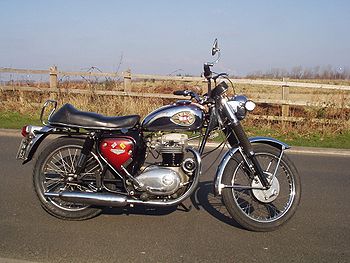BSA Thunderbolt/reviews
BSA 650cc Thunderbolt Review[edit | edit source]
Motorcyclist Illustrated November 1967
The BSA Thunderbolt, as you probably know, is the single-carburetor version of the twin-cylinder 654cc BSA range, made with the sidecar man in mind. But there are those who, with no intentions of ever adding another wheel, prefer a single-carb machine. Not so fickle, nor do you have to worry about synchronisation. And performance differential is hardly worth.
Despite its re-styling, I still found the Thunderbolt reminiscent of the old BSA Gold Flash. If you have a successful basic formula, why bother to change it?
The 75 mm x 74 mm engine is identical, but for cams and compression ratio, to that of the quicker 654 cc machines. While the Spitfire Mk III, the Hornet and the Wasp have a 10.5: 1 or, the Thunderbolt and the Lightning, surprisingly - has 9.0:1. Gear ratios of the Lightning, Thunderbolt and Spitfire are identical, each having a 20 tooth gearbox sprocket, a 47 tooth rear wheel sprocket and a 4.87:1 top gear. So, despite the reputation, a well-earned one, of the sports models, the Thunderbolt would never be far behind.
They're a handsome bunch, too. Sit astride, and you'll find yourself looking down at a chromium-plated headlamp embracing the lighting switch and ammeter, and a conventional handlebar layout. Dip switch and horn button are incorporated in the left-hand grip. On this model, there is no tachometer, and the 150 mph speedometer is rubber-mounted at the top of the left fork leg.
Gear change lever readily adjustable and rear brake lever are comfortably situated, but I wouldn't say that this was the most comfortable machine I had ever ridden. The petrol tank tends to be bulky, rather than sleek, forcing one's knees rather far apart. And I found the suspension, both front and rear, to be hard, giving, after a long trip, a jarring ride. This, no doubt, was due to the heavier springing provided for use with a sidecar, tout gave the impression of a progressively-hardening saddle.
Road holding is excellent. For a big bike, weighing 391 lb, it could be cornered with the utmost confidence, in both wet and dry road conditions. Braking was to match, particularly the 8-dn front unit, which could always be relied upon to retard one's progress as rapidly as was mechanically possible.
Petrol consumption varied from as little as an approximate 42 mpg during a motorway thrashing to as much as 65 mpg on my day's outing.
Lighting is, as may be expected, well up to scratch, the headlamp always providing sufficient power, in keeping with road-speed at eight. The horn had a strangely muted sound, but was always sufficient warning for other road-users.
If you're a prize chrysanthemum grower or dahlia-fancier, and you would like a little heaven-sent rain to freshen-up your little treasures, drop me a line. I couldn't really be accused of being a "fair-weather" motorcyclist because, with only one exception in the past twelve months, it has rained during each of my road-tests. Not just rained. The sort of stuff that, if Noah was still around, would send him rushing to the do-it-yourself shop with an open cheque and an order for 15 cwt. of six-inch nails. Not that I mind a little rain. It's a lot of it that I object to.
We splashed our way through the streets of London which, at that hour, seem only to be used by car-loads of burly men wearing concrete-impregnated jackets and Wellington boots with a 10-inch turn-over.
In traffic, you would never imagine that it was a 650 on which you were sneaking through, except when the throttle is opened and the acceleration .gives a sharp reminder.
From Staines, we continued along A30 past Basingstoke. after which we forked right on A303 to Andover, cruising at a steady 60-65 mph, despite diabolical weather, and ducking beneath great clouds of spray thrown up by west-bound lorries.
Through Andover, out on the A303 past Weyhill (and Thruxton), then off to the left and the old city of Salisbury, lording it over its Plain.
Picking up the A30 again to Shaftesbury, we passed through Sherborne and across the county 'border into Somerset and Yeovil, where a right turn will take you up the Roman road to Ilchester (Ischalis). This route rarely follows the line of the Roman road, which ran from Staines to Silchester (Cal-leva), 'but is its approximate counterpart.
And now one is on Fosse Way, truly one of Britain's oldest roads, up on A429 to Stow-on-the-Wold, Moreton-in-Marsh, crossing in an almost straight line the A34. Through the village of Halford, and in a quarter of a mile or so the A429 bears left for Warwick.
In about 200 yards, the B4451 bears right and a lane goes straight ahead. This is the Fosse Way proper, and taking it ft like going 'back into history. Almost straight as a die, it carries on for almost 30 miles to become B4029 just before Brinklow.
Turn right here, and you are back in 1967, on a modern motorcycle, and it's still pouring with rain. Down the A5, passing Towcester (Lactodorum), and along this fine Roman road brings you back into North London.
There you are. If you want an unusual day out, try this route. And if you want superb motorcycling, try a BSA Thunderbolt.
